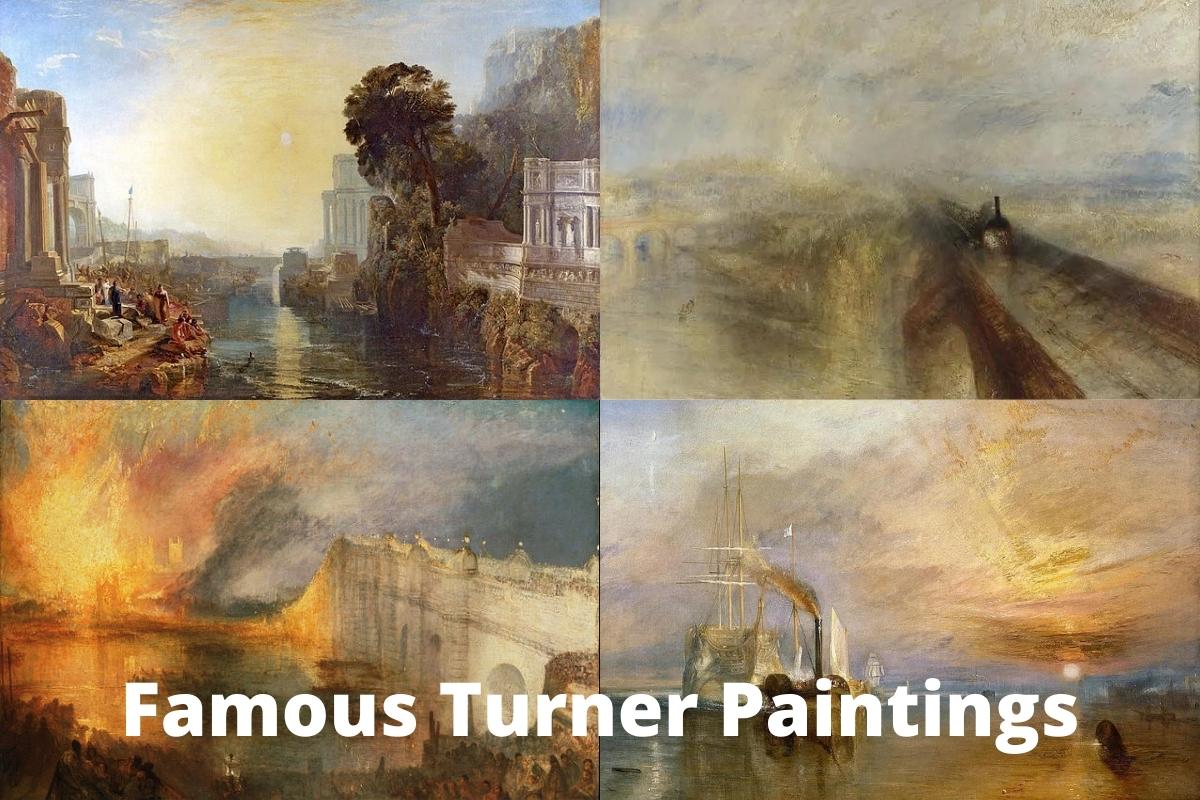Joseph Mallord William Turner RA (23 April 1775 – 19 December 1851), also known as William Turner at the time, was an English Romantic painter, printmaker, and watercolorist.
He is well-known for his expressive colorizations, innovative landscapes, and stormy, sometimes violent maritime paintings. More than 550 oil paintings, 2,000 watercolors, and 30,000 works on paper were left behind by him.
Many of Turner’s early drawings were architectural studies or exercises in perspective, and he is known to have worked for various architects as a young man.
Turner started his studies with topographical draughtsman Thomas Malton, who specialized in views of London. Turner acquired the fundamentals of the profession from him, duplicating and coloring outline prints of British castles and abbeys. Topography was a growing enterprise at the time that might help a young artist pay for his education.
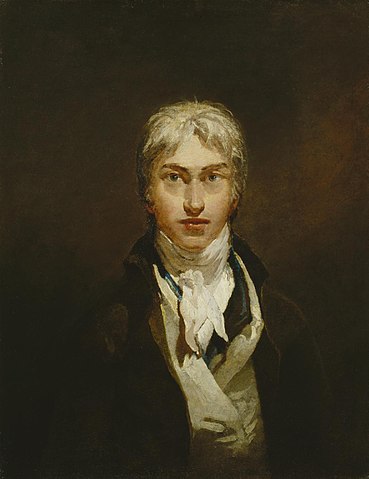
Turner attended the Royal Academy of Art at the age of 14 in 1789 and was admitted a year later by Sir Joshua Reynolds. He had an early interest in sketching building, but was urged to concentrate on painting instead.
Turner was 15 when his first watercolor, A View of the Archbishop’s Palace, Lambeth, was approved for the Royal Academy summer exhibition in 1790.
Turner’s first oil painting for the school, Fishermen at Sea, was a nighttime moonlight picture of the Needles off the Isle of Wight, an image of boats in danger, completed in 1796.
Turner’s reputation as an oil painter of sea settings was established with this painting, which was lauded by contemporary reviewers.
Turner traveled extensively around Europe, beginning with France and Switzerland in 1802 and continuing with studies at the Louvre in Paris the following year. He also made several trips to Venice.
Turner employed oils more plainly in his latter years, evoking virtually pure light via the use of shimmering hue. Rain, Steam, and Speed – The Great Western Railway is a superb illustration of his mature style, with things that are scarcely discernible.
The intensity of color and concern in evanescent light not only propelled Turner’s work to the forefront of English painting, but also had an impact on French art; the Impressionists, notably Claude Monet, meticulously studied his methods. He is also often considered as the forefather of abstract painting.
He had an unusual life and, while he never married, he had an affair with an older widow named Sarah Danby. He is said to have fathered her two children, Evelina Dupois and Georgiana Thompson.
Many of Turners greatest works are now considered national treasures in Britain.
Famous Turner Paintings
1. The Fighting Temeraire
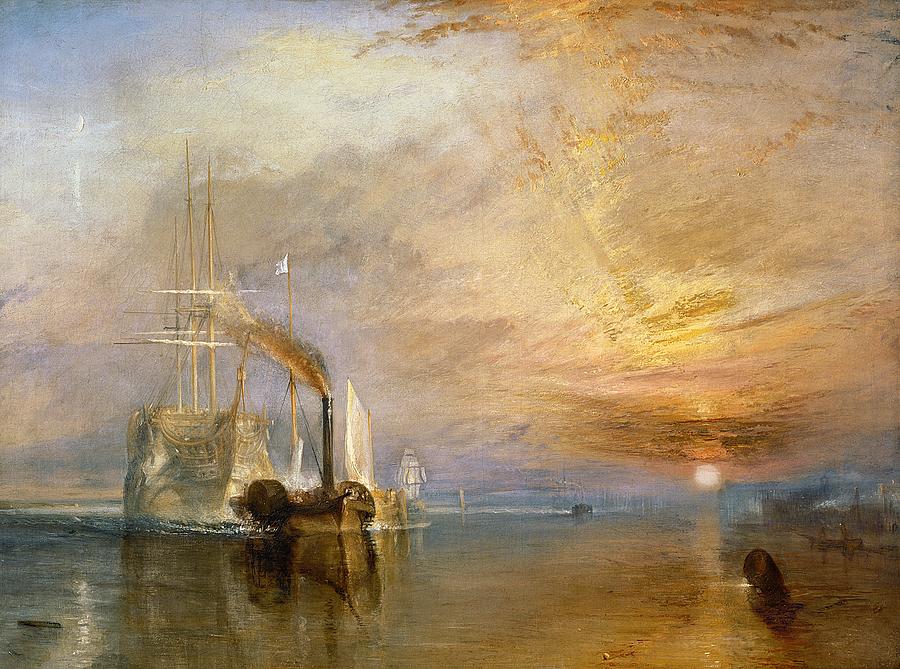
Turner’s oil painting The Fighting Temeraire (full name: The Fighting Temeraire, tugged to her last berth to be broken up), was completed in 1838 and exhibited at the Royal Academy in 1839.
The picture shows the 98-gun HMS Temeraire, one of the last second-rate ships of the line to take part in the Battle of Trafalgar, being towed up the Thames by a paddle-wheel steam tug in 1838, towards her last berth at Rotherhithe to be broken up for scrap.
The artist bequeathed the picture to the country in 1851, and it now sits in the National Gallery in London. It was chosen as the nation’s favorite artwork and is was featured on the new £20 note.
Also Read: Famous British Art
Turner was at the pinnacle of his career when he arrived to create this piece, having shown at the Royal Academy in London for 40 years.
He was well-known for his intensely atmospheric paintings in which he investigated weather, the sea, and the influences of light.
He spent most of his time along the River Thames and painted several watercolor and oil paintings of ships and waterside settings. Turner regularly drew small preparatory drawings, which he eventually turned into completed paintings in his workshop.
2. Rain, Steam and Speed – The Great Western Railway
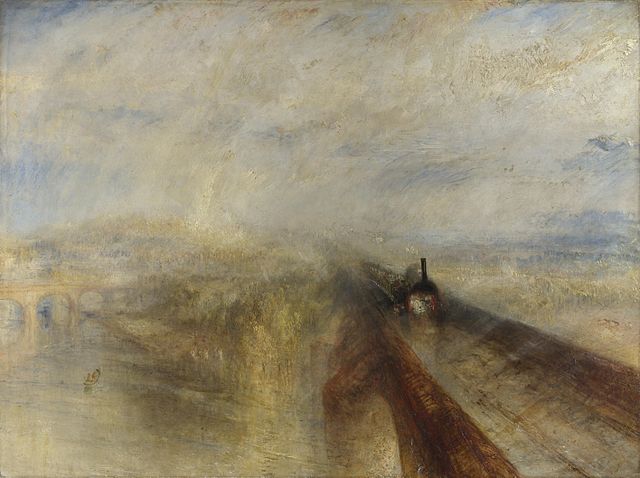
Rain, Steam, and Speed – The Great Western Railway is an oil painting by J. M. W. Turner, that was initially shown at the Royal Academy in 1844, however it might have been done earlier. It is presently housed at the National Gallery in London.
Also Read: Paintings in London
Turner’s painting offers the sense of immense speed in a static work, which separated him from other painters. The piece mixes the force of nature and technology to generate an emotional tension linked with the sublime notion.
The picture was completed around the conclusion of the Industrial Revolution, which saw a significant transition in the Victorian era from an agricultural economy to one dominated by machine manufacture.
The railway was one of the most powerful symbols of industrialization, since this new mode of transportation had a significant impact on both industrial and social life.
Turner seemed to be a generation ahead of other artists since he was one of the few painters at the time who saw industrial progress as a worthy topic of art. The picture implies that contemporary technology is a reality that is rushing towards us.
3. Snow Storm: Steam-Boat off a Harbour’s Mouth
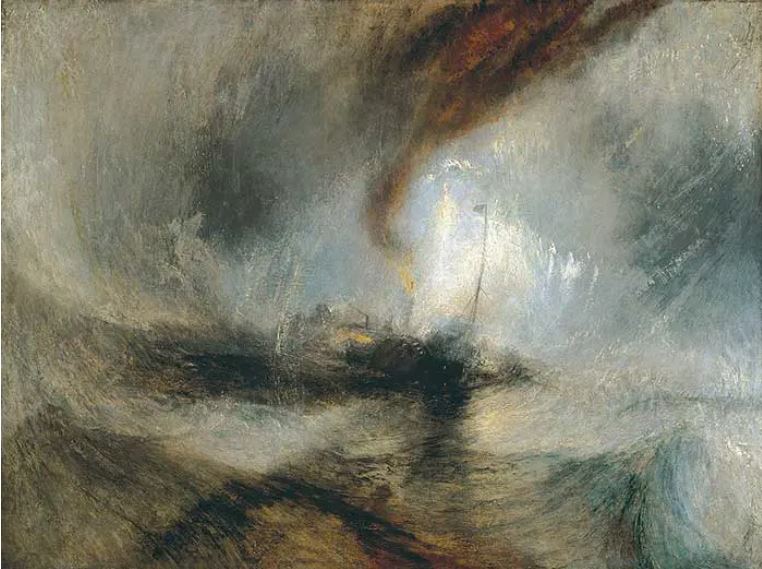
Snow Storm, or Snow Storm: Steam-Boat off a Harbour’s Mouth (full title: Snow Storm – Steam-Boat off a Harbour’s Mouth Making Signals in Shallow Water and Going by the Lead) is a oil on canvas painting that was completed in 1842.
Early reactions to the artwork were mostly unfavorable, with one reviewer referring to it as “soapsuds and whitewash.”
Despite being blasted by many contemporaneous reviewers, John Ruskin wrote in 1843 that it was “one of the very finest representations of sea-motion, mist, and light that has ever been placed on paint.”
In the preceding decade, Turner had explored the interplay between nature and the new technology of steamboats in at least five works. Turner was interested in urbanization, industry, railways, and steam power throughout his career.
A paddle ship is stuck in a snowstorm in the picture. This maritime picture exemplifies a Romantic-era painter’s representation of a snowfall on water at its finest, completely realizing Turner’s strong, adventurous Romantic imagination.
Turner was unequaled in representing the uncontrollable natural world and investigating the influence of the elements and the conflict of nature’s forces.
Turner began his career as a watercolor artist before transitioning to oils considerably later. He eventually used the watercolor skills he had acquired to oil paintings.
It is indicative of Turner’s late style. Turner’s tints and hues are painted in several layers of color, with brushstrokes providing texture to the work.
The colors are monochromatic, with just a few tones of grey, green, and brown all having the same tone. The silvery pale light around the boat serves as a focus point, bringing the spectator into the artwork. The steamboat’s smoke spreads over the sky, forming abstract forms with the same character as the waves.
4. The Slave Ship
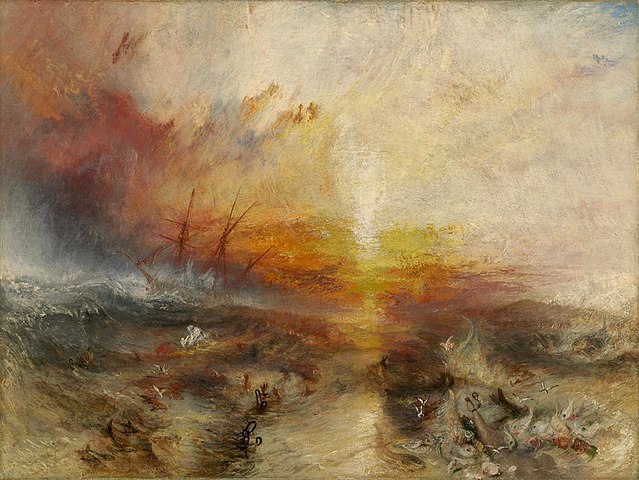
The Slave Ship, also known as Slavers Throwing Overboard the Dead and Dying—Typhoon Coming On, is an oil on canvas picture that was first shown at The Royal Academy of Arts in 1840.
It is presently on exhibit in the Museum of Fine Arts, Boston, and measures 35+34 in 48+14 in (91 cm 123 cm).
Turner shows a ship seen in the backdrop traveling over a stormy sea of churning water, leaving dispersed human shapes floating in its wake in this famous example of a Romantic marine painting.
Turner was perhaps inspired to paint The Slave Ship after reading about the slave ship Zong in Thomas Clarkson’s The History and Abolition of the Slave Trade, the second edition of which was released in 1839.
The painting’s first showing, in 1840, coincided with worldwide abolitionist activities. As the painting changed hands throughout the years, it was exposed to a variety of competing interpretations.
While the work is universally acclaimed for its magnificent atmospheric effects, there are differing views on the piece’s connection to its subject matter.
5. Dido Building Carthage
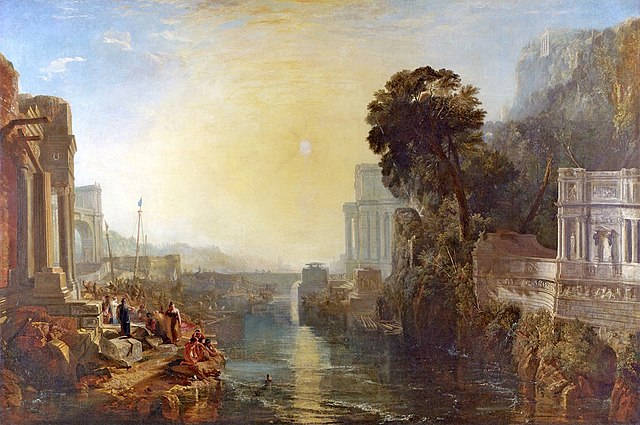
J. M. W. Turner painted Dido Building Carthage, or The Rise of the Carthaginian Empire, as an oil on canvas. The painting is one of Turner’s most notable works, heavily inspired by Claude Lorrain’s bright classical landscapes.
Turner referred to it as his chef’s d’oeuvre. He held onto the painting until he donated it to the country in the Turner Bequest after first exhibiting it at the Royal Academy summer exhibition in 1815. The National Gallery in London has owned it since 1856.
The motif is a classical countryside from Virgil’s Aeneid. Dido, the figure in blue and white on the left, is guiding the construction of Carthage’s new city. The person in front of her, dressed in armour and facing the spectator, might be her Trojan lover Aeneas.
Some children are playing with a frail toy boat in the sea, symbolizing Carthage’s rising but fragile naval strength, while the grave of her late husband Sychaeus, on the right side of the picture, on the opposite bank of the estuary, foreshadows Carthage’s impending tragedy.
Most of Turner’s works were eventually moved to the Tate Gallery in the early twentieth century, but Dido building Carthage and Sun rising through Vapour remain at the National Gallery, shown alongside the Claudes; a few other selected works by Turner, including Rain, Steam and Speed and The Fighting Temeraire, remain at the National Gallery as examples of English painting.
6. The Burning of the Houses of Parliament
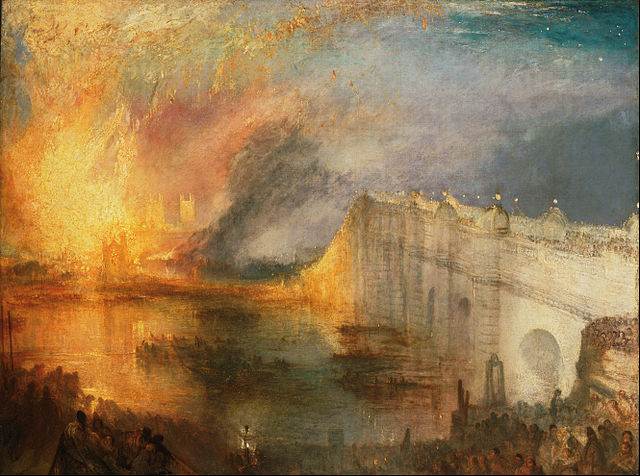
The title of two oil on canvas paintings by J. M. W. Turner(The Burning of the Houses of Lords and Commons) showing the fire that broke out at the Houses of Parliament on the evening of October 16, 1834.
Turner, like hundreds of other onlookers, observed the burning of Parliament from the south bank of the Thames, opposite Westminster.
He sketched in two sketchbooks with pencil and watercolor from various vantage points, including a hired boat, however it is unclear if the works were created instantaneously, en plein air.
Turner bequeathed the sketchbooks to the National Gallery as part of the Turner Bequest, and they are presently kept by the Tate Gallery.
Other drawings in Turner’s sketchbooks, formerly assumed to depict the Burning of Parliament, have been evaluated and may depict the fire that destroyed the Grand Storehouse at the Tower of London on 30 October 1841.
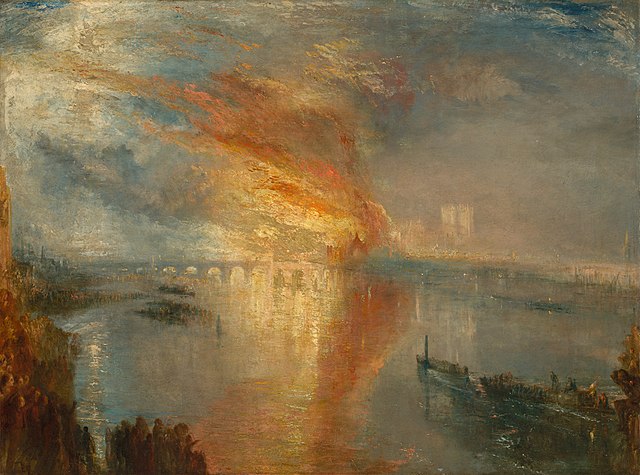
Both paintings were completed in late 1834 or early 1835 and size 92.1 cm (36.3 in) by 123.2 cm (36.3 in) (48.5 in). Turner reworked both works for several hours on the varnishing day, just before the show opened to the public.
The first canvas, which was shown at the British Institution in February 1835, depicted the Houses of Parliament from the upstream side of Westminster Bridge. The buildings on the other bank of the river are engulfed in golden flames.
Parts of the picture were most likely inspired by a newspaper story that Turner read the day after the fire in The Times. The Philadelphia Museum of Art acquired the artwork in 1928 as part of the John Howard McFadden Collection.
The second painting was shown in the Royal Academy’s summer exhibition later that year and was bought by the Cleveland Museum of Art as a donation from John L. Severance in 1942.
It depicts a similar view from farther downstream, closer to Waterloo Bridge, with flames and smoke being thrown spectacularly across the Thames while onlookers on the river bank and in boats watch.
7. Fishermen at Sea
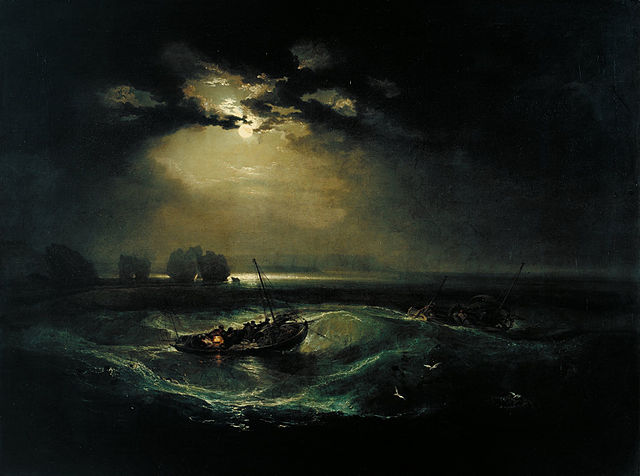
Fishermen at Sea is an early oil painting by J. M. W. Turner, often known as the Cholmeley Sea Piece. It was first shown at the Royal Academy in 1796 and has been in the Tate Gallery’s collection since 1972. The picture is 36 by 48.125 inches (91.44 cm 122.24 cm) in size.
It was Turner’s first painting to be shown at the Royal Academy. It was appreciated by contemporary reviewers and established Turner’s reputation as an oil painter as well as a painter of nautical themes.
The picture portrays a moonlight vista of fisherman on choppy waves near the Isle of Wight’s Needles.
It contrasts the fragility of human existence, symbolized by the little boat with its flickering lantern, with nature’s immense strength, depicted by the dark overcast sky, broad sea, and frightening cliffs in the backdrop. The Moon’s frigid light at night contrasts with the warmer glow of the fishermen’s lantern.
8. Light and Colour (Goethe’s Theory) – The Morning after the Deluge – Moses Writing the Book of Genesis
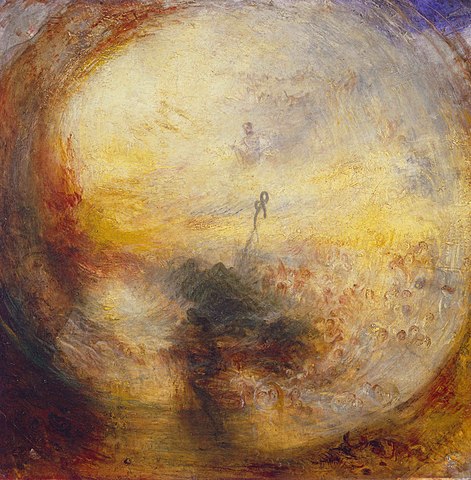
This work, created in the final years of Turner’s career, represents the aftermath of the Great Flood tale found in the Book of Genesis.
Man’s position is represented as passive because to his incapacity to manage nature, which is visually appealing yet has the power to destroy and restore life.
Turner’s conviction in God’s omnipotence is also reflected in this poem, since it is He who causes the deluge, permits Noah to live, and inspires Moses to write the Book of Genesis. In this scenario, Genesis refers to the creation of man, light, and the water on which light is reflected.
Turner was known for his watercolor and oil paintings that portrayed landscape imagery and sceneries of natural phenomena such as the weather, the ocean, the influence of light, and vision throughout the most of his career.
Turner seeks to support the concept that the eye is constantly attempting to generate a picture as it strives to replicate nature via the blurring of images. Color is often utilized as a companion to form, but Turner’s fascination to light and color enables color to replace form.
9. Norham Castle, Sunrise
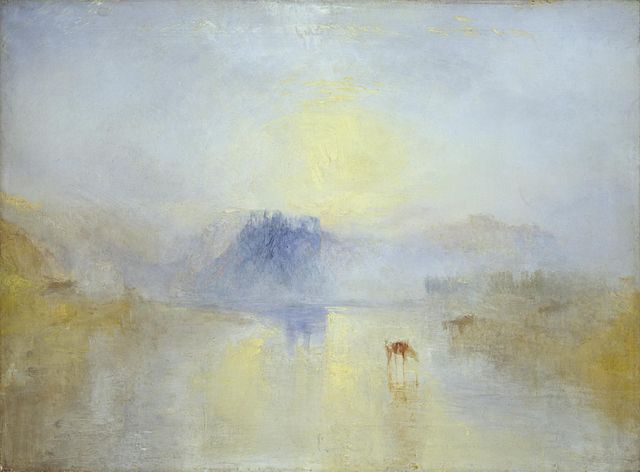
Norham Castle, Sunrise is an oil painting on canvas that was completed about 1845. The picture was donated to the National Gallery of British Art (now Tate Britain) in 1856 as part of the Turner Bequest, and it is still in the collection today.
Norham is a settlement in Northumberland, England, on the English-Scottish border. The castle was an important fortification overlooking the River Tweed and was regularly assaulted by the Scots.
Turner paid a visit to the castle and surrounding countryside in 1797. Following his voyage, Turner made the watercolor Norham Castle: Sunrise, which was shown to critical acclaim at the Royal Academy of Arts in 1798.
In 1801, Turner returned to the ruins. Turner started working on his Liber Studiorum, a series of monochrome landscape prints, in 1806. Norham Castle, Sunrise was one of a number of incomplete colored reworks of these prints.
10. Snow Storm: Hannibal and his Army Crossing the Alps
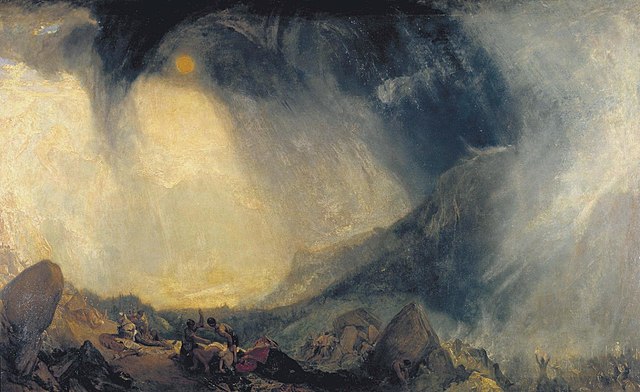
J. M. W. Turner’s Snow Storm: Hannibal and his Army Crossing the Alps is an oil on canvas artwork that was originally shown in 1812. The Turner Bequest left it to the nation, and it was bought by the National Gallery in London in 1856, and it is today housed by the Tate Gallery.
The artwork represents Hannibal’s armies’ attempt to traverse the Maritime Alps in 218 BC, which was thwarted by natural forces and native tribes.
The sky is dominated by a curved black storm cloud, ready to drop on the troops in the valley below, with an orange-yellow Sun struggling to burst through the clouds.
To the right, a white avalanche pours down the mountain. Hannibal is not clearly portrayed, although he may be riding the elephant in the distance. The storm and the environment dwarf the enormous animal, with the bright fields of Italy extending out beyond.

